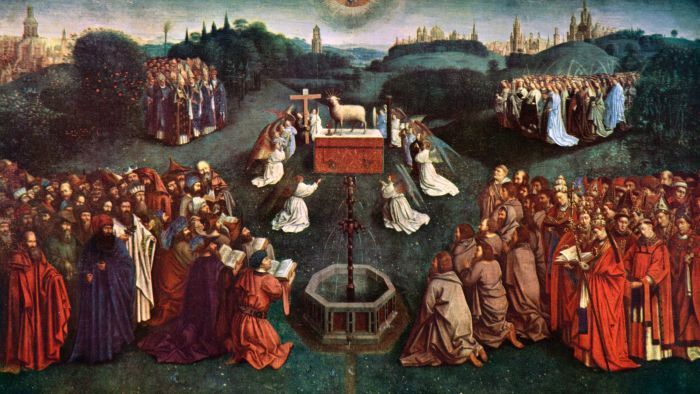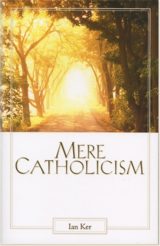By Fr. Ian Ker
Fr. Ian Ker is the leading expert on the life and works of John Henry Newman. He is the author of several books, including Mere Catholicism.

The original chosen people offered up two kinds of sacrifice: holocausts in which the entire animal was offered to God, and “peace offerings” in which only a choice part of the victim was offered to God, while the remainder provided a banquet for the offerer and his friends and family. In the latter kind of sacrifice, the sharing of the animal by God and human beings established a sort of communion between them. In what sense can the Eucharist be a sacrifice when no killing takes place? And how can Catholics identify the Eucharist with the sacrifice which took place on the Cross? After all, Jesus’ recorded words only speak about a memorial—“Do this in remembrance of me” (Luke 22:19).
It all depends on what one means by memory. Memory can be as dynamic as it can be inert. When Jesus instructed His Church to do what He had done “in memory” of Him, this doesn’t at all have to imply the kind of memorial that simply calls to mind what can no longer be experienced, what is now buried in the past. When the Jews celebrated their Passover, this liberating event was meant to be recreated, to become vividly real again in the present, rather than merely recollected as a past event, the importance of which now lay in the past. Instead, the Passover meal was intended to bring home to the Jews the reality of their liberation, with all its implications for their lives as God’s chosen people.
Similarly, in the Eucharist, the new Passover, Christ’s liberating death can be said to be recreated, not in the sense of happening again as it happened on Calvary, but of happening again in a different way altogether. The couple who renew their marriage vows are not getting married as they did on their wedding day, but they are confirming and endorsing their marriage, and this confirmation and endorsement are qualitatively different from the couple saying to each other over an anniversary dinner how glad they are that they got married. By literally redoing what they did on that original day, they do in a very real sense return to that day, which once again becomes a present reality. The wedding can’t be repeated—and yet it can be.
In the Eucharist, Christ’s sacrificial death becomes a present reality, not in a literal physical sense since Christ cannot die again as He died on Good Friday, but in a quite different sacramental way. A historical event, like the crucifixion, happens only once, and yet like any significant historical event it remains in the historical consciousness as a present reality. What was achieved on the Cross for the world was achieved once and for all on that day and can’t and doesn’t need to be repeated. But what was achieved persists and remains as a victorious liberation which still affects the world. And so in the Eucharist this abiding, ever-present reality is commemorated in the sense of being re-presented by the repetition of the self-sacrificial words of Christ at the Last Supper when He anticipated His actual execution—“This is my body which is given for you” (Luke 22:19) and “This cup which is poured out for you is the new covenant in my blood” (Luke 22:20). Thus in the Eucharist as at the Last Supper, although now retrospectively rather than in anticipation, Christ offers up the Body and the Blood He shed for us on the Cross—yes, again and, of course, not again. The Eucharist can still be the same sacrifice of Himself that Jesus offered to the Father on behalf of the world without any blood being actually spilt, any actual physical flesh suffering. It is the same sacrifice, like the Last Supper itself, but it is the manner of the offering which is different.
The bread and wine that the ancient Jews offered in sacrifice to God in thanksgiving for the gift of food and drink took on a wholly new dimension in the Passover meal when, instead of the usual leavened bread, unleavened bread was eaten to indicate the haste with which their escape from slavery in Egypt was accomplished. The new Passover, in which Christ passes from this world to His Father, is celebrated and commemorated by Him in a meal in which the unleavened bread is now designated in such a way that it replaces the old lamb of the Jewish Passover—since the sacrificial lamb is now the very person presiding at the meal, Christ Himself. As for the special blessing of the wine which took place at the end of the Passover meal, that now becomes the blood of the new pact between God and His people—the Blood of Christ as opposed to the blood of a sacrificed animal which sealed the old pact between God and His chosen people. And finally, Christ Himself clearly indicates that this transformed meal itself looks forward to an even more wonderful feast in heaven.
You Might Also Like

Catholicism can mystify or even repel other Christians, while its complexities can confuse Catholics themselves. Fr. Ian Ker’s stimulating book, Mere Catholicism makes Catholicism come alive as the fullness of Christianity.

